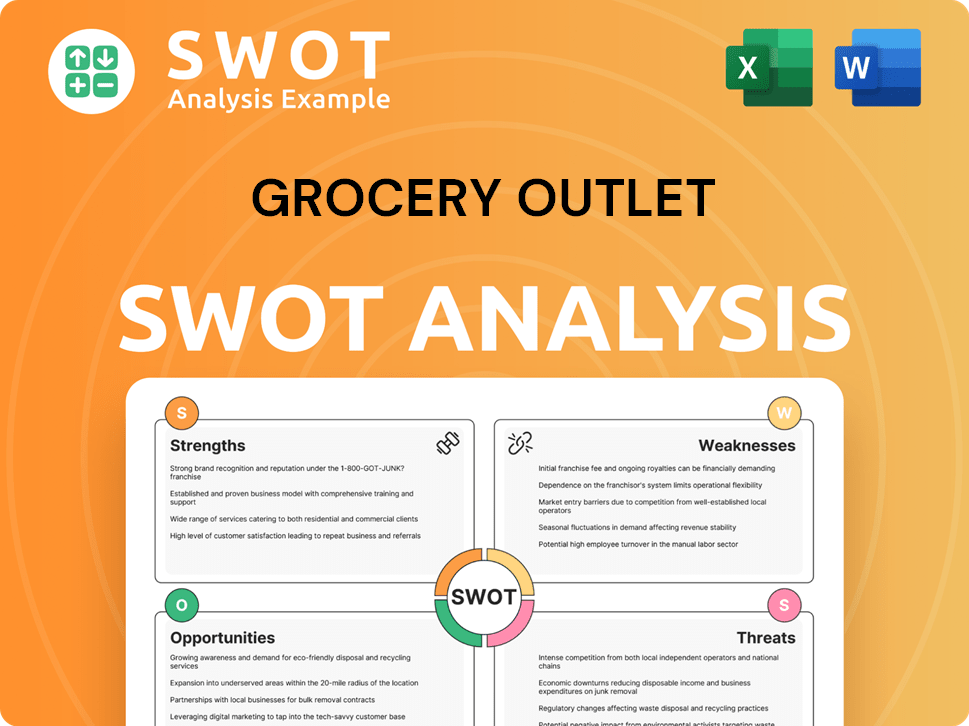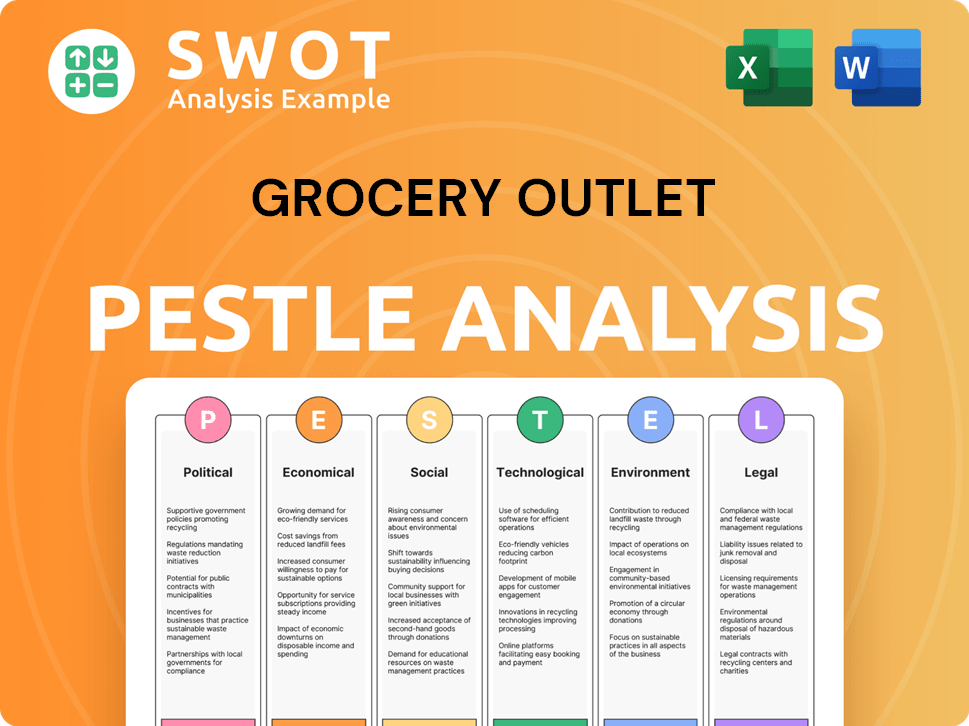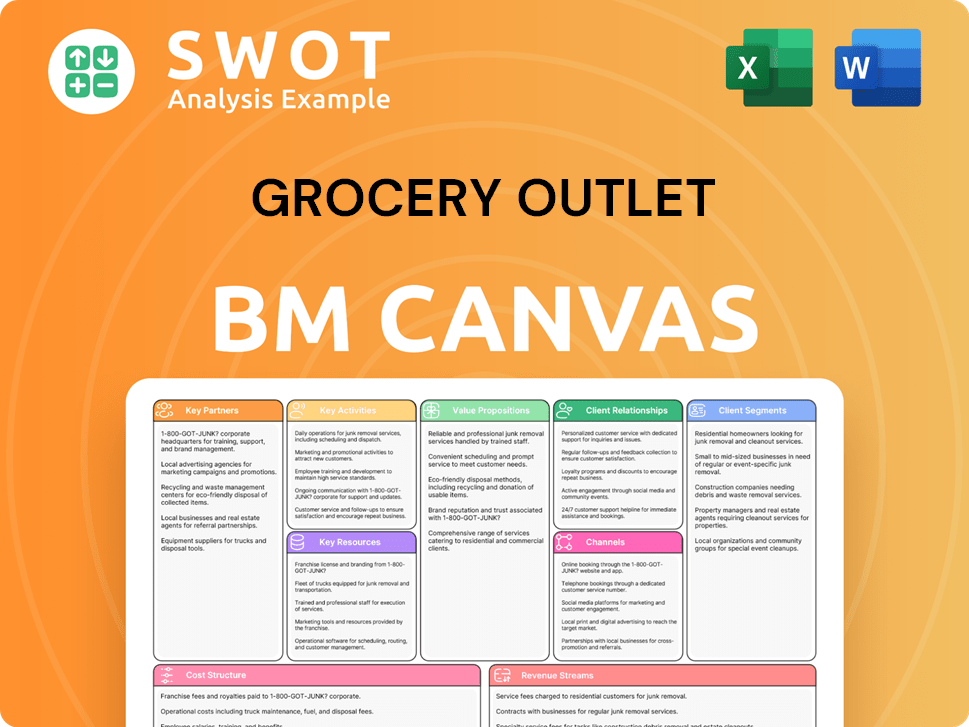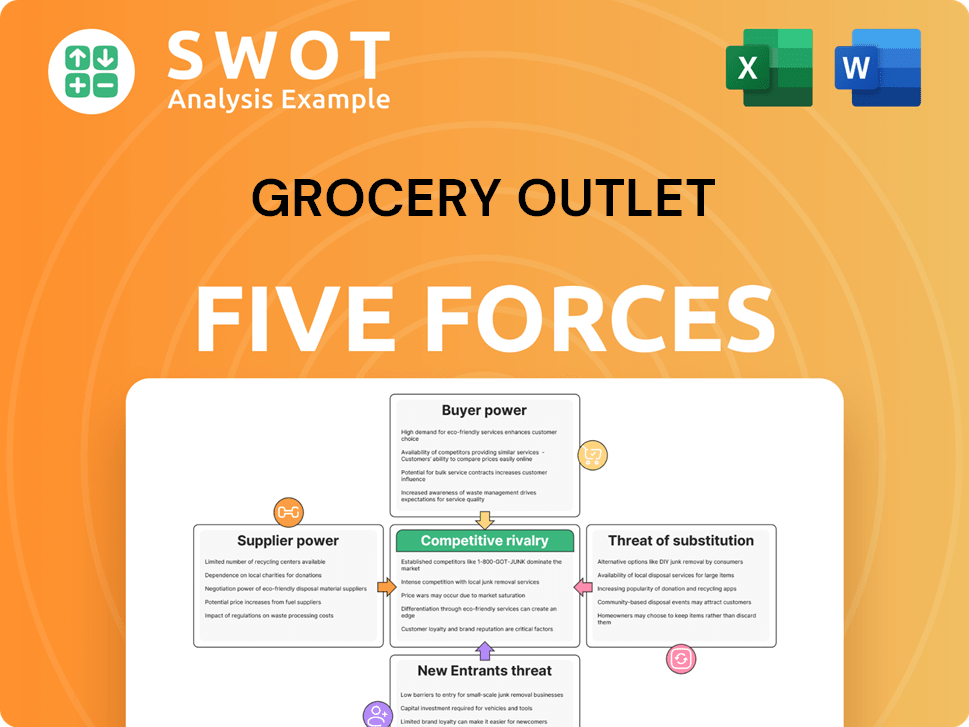Grocery Outlet Bundle
How Does Grocery Outlet Thrive in a Cutthroat Market?
The grocery retail sector is a battlefield, constantly reshaped by consumer trends and economic forces. Grocery Outlet Holding Corp. has carved a unique path, offering deep discounts on name-brand products. This strategy has allowed the company to not only survive but thrive, even as traditional grocery chains and e-commerce giants vie for market dominance.

Founded in 1946, Grocery Outlet's innovative approach of buying excess inventory at low prices has fueled its growth, transforming it into a leading extreme value retailer. This Grocery Outlet SWOT Analysis offers a deeper dive into the company's competitive strengths. Today, we'll dissect the Grocery Outlet competitive landscape, identify its key Grocery Outlet competitors, and conduct a thorough Grocery Outlet market analysis to understand its unique position within the grocery store industry and the world of discount grocery stores. The Grocery Outlet business model is a key factor in its success.
Where Does Grocery Outlet’ Stand in the Current Market?
Grocery Outlet's core operations center around its unique value proposition as an extreme value retailer. This means the company offers a wide variety of groceries and general merchandise at deeply discounted prices. They achieve this through an opportunistic buying model, purchasing overstocked or surplus products from various suppliers.
The company's business model allows it to provide significant savings to its customers. This approach contrasts with traditional grocery stores, which often have higher prices due to different sourcing and operational strategies. This value-driven model is a key factor in the Grocery Outlet competitive landscape.
Grocery Outlet holds a distinct market position within the grocery store industry, specifically in the discount segment. The company operates as an extreme value retailer, offering groceries and other products at significantly reduced prices. This positioning attracts budget-conscious consumers and those seeking unique finds.
As of early 2024, Grocery Outlet operated over 460 stores across eight states. These states include California, Oregon, Washington, Pennsylvania, and New Jersey, demonstrating a strong presence on both the West and East Coasts. This geographic footprint is a key aspect of its market strategy.
The primary target customer for Grocery Outlet is budget-conscious consumers. These shoppers are looking for significant savings on their grocery bills. The company also appeals to customers seeking unique and fluctuating inventory, which adds to its appeal.
For the fiscal year 2023, Grocery Outlet reported net sales of $3.96 billion, a 10.9% increase compared to the previous year. This growth rate highlights the effectiveness of its business model. Its profitability within its segment is competitive, particularly in its home state of California.
Grocery Outlet's success is rooted in its value proposition and opportunistic buying strategy. They offer a wide range of products at discounted prices, attracting a loyal customer base. The company continually adapts and expands its product assortment to cater to a broader range of consumers.
- Discount Pricing: Offers significant savings on groceries and general merchandise.
- Opportunistic Buying: Purchases overstocked or surplus products.
- Geographic Expansion: Growing its store footprint across multiple states.
- Product Diversification: Expanding to include more organic and specialty items.
Grocery Outlet's market position within the discount grocery sector is strengthened by its ability to offer competitive prices and a unique shopping experience. Understanding the Target Market of Grocery Outlet provides further insights into the company's strategic approach and customer base, which is crucial for analyzing the Grocery Outlet competitive landscape.
Grocery Outlet SWOT Analysis
- Complete SWOT Breakdown
- Fully Customizable
- Editable in Excel & Word
- Professional Formatting
- Investor-Ready Format

Who Are the Main Competitors Challenging Grocery Outlet?
The Marketing Strategy of Grocery Outlet faces a dynamic competitive landscape. This landscape includes a variety of retailers, all vying for consumer spending in the grocery sector. Understanding these competitors is crucial for evaluating the company's position and potential for growth.
The competitive environment for Grocery Outlet is multifaceted, encompassing direct and indirect rivals. These competitors employ various strategies to attract customers, from aggressive pricing to unique shopping experiences. Analyzing these strategies provides insight into the challenges and opportunities for Grocery Outlet.
Grocery Outlet competes with a range of players in the grocery market, each with its own strengths and strategies. This analysis considers both direct competitors, like other discount grocers, and indirect competitors, such as mass merchandisers and online retailers. The goal is to provide a comprehensive view of the competitive pressures and opportunities.
Direct competitors include discount grocery chains like Aldi and Lidl. These retailers focus on low prices and private-label goods, directly challenging Grocery Outlet's value proposition. Aldi, known for its limited assortment and efficient supply chain, has a strong presence in the discount grocery market.
Grocery Outlet also competes with larger supermarket chains such as Kroger, Albertsons, and Ahold Delhaize. These chains often have discount sections and private-label offerings to retain budget-conscious customers. They leverage their established brand recognition and store networks.
Mass merchandisers like Walmart and Target are significant competitors. Walmart, with its 'Every Day Low Prices' strategy and extensive supply chain, poses a formidable challenge. These retailers offer a wide range of products, including groceries, at competitive prices.
Indirect competition comes from warehouse clubs such as Costco and Sam's Club. They offer bulk discounts, attracting customers looking to save on larger quantities of groceries. These clubs also provide a unique shopping experience.
Dollar stores like Dollar General and Dollar Tree are also expanding their food offerings, increasing competition. These stores offer low prices and convenience, appealing to budget-conscious consumers. They are becoming more significant players in the grocery store industry.
Online retailers like Amazon Fresh and Instacart present a growing challenge, although Grocery Outlet's in-store treasure hunt experience is difficult to replicate online. The convenience of online grocery shopping continues to attract customers. The online presence of competitors is a factor in the Grocery Outlet competitive landscape.
The Grocery Outlet competitive landscape is constantly evolving. The Grocery Outlet market analysis shows that mergers and acquisitions, such as the proposed Kroger-Albertsons merger, could reshape the competitive dynamics. These changes can create larger, more dominant players with increased purchasing power. The emergence of new players, such as local food delivery services and specialty ethnic markets, adds further complexity to the market. Understanding the Grocery Outlet competitors and their strategies is essential for the company to maintain and grow its market share.
Several factors influence the competitive dynamics in the grocery market. These factors include pricing strategies, supply chain efficiency, store format, and customer demographics. The ability to offer competitive prices while maintaining profitability is crucial.
- Pricing Strategy: Discount grocers like Aldi and Lidl compete primarily on price, offering lower prices than traditional supermarkets. Grocery Outlet's pricing strategy focuses on offering significant discounts compared to conventional retailers.
- Supply Chain Efficiency: Efficient supply chains are critical for minimizing costs and maintaining low prices. Aldi and Walmart have highly optimized supply chains, allowing them to offer competitive prices. Grocery Outlet's opportunistic buying model also plays a role in its supply chain.
- Store Format and Experience: Store format and the overall shopping experience influence customer preferences. Lidl's modern stores and Grocery Outlet's treasure hunt experience are examples of differentiated store formats.
- Customer Demographics: Understanding the target customer base is essential for tailoring marketing and product offerings. Grocery Outlet targets value-conscious consumers, while other retailers cater to different demographics.
- Online Presence: The growth of online grocery shopping has increased the importance of digital platforms. Amazon Fresh and Instacart are significant players in this space. Grocery Outlet's online presence is limited compared to some competitors.
Grocery Outlet PESTLE Analysis
- Covers All 6 PESTLE Categories
- No Research Needed – Save Hours of Work
- Built by Experts, Trusted by Consultants
- Instant Download, Ready to Use
- 100% Editable, Fully Customizable

What Gives Grocery Outlet a Competitive Edge Over Its Rivals?
The Growth Strategy of Grocery Outlet highlights the company's unique position in the Grocery Outlet competitive landscape. Grocery Outlet's competitive advantages stem from its opportunistic buying model and independent operator structure. This allows the company to offer significant discounts, typically between 40% and 70% below conventional retail prices, appealing to value-conscious consumers. This approach has helped Grocery Outlet establish a strong presence in the discount grocery stores sector.
Grocery Outlet's business model focuses on purchasing overstocked and closeout merchandise directly from name-brand suppliers. This strategy, combined with a lean operating model, contributes to higher margins despite the deep discounts. The independent operator model fosters a strong entrepreneurial spirit, enabling stores to tailor their offerings to local preferences and build strong community ties. This decentralized structure allows for quick responses to market changes, a key factor in the Grocery Outlet market analysis.
The 'treasure hunt' shopping experience created by the ever-changing inventory encourages frequent visits and fosters customer loyalty. Grocery Outlet's success is also supported by its strong relationships with thousands of suppliers, ensuring a consistent flow of discounted goods. These relationships are crucial for maintaining its competitive edge in the grocery store industry.
Grocery Outlet purchases overstocked and closeout merchandise directly from name-brand suppliers. This allows the company to offer products at prices significantly lower than conventional retailers. This model requires strong supplier relationships and efficient logistics to maintain a consistent flow of discounted goods. This is a key element in the Grocery Outlet value proposition.
Each store is run by an independent owner-operator from the local community. This fosters an entrepreneurial spirit and allows for tailored product assortments. Independent operators can quickly adapt to local demand and build strong community ties. This localized approach often results in higher employee engagement and better customer service.
Grocery Outlet operates with lower overhead costs compared to traditional grocery stores. This efficiency, combined with opportunistic buying, contributes to higher margins. The lean structure supports the company's ability to offer deep discounts while maintaining profitability. This advantage is crucial in the Grocery Outlet vs Trader Joe's comparison.
The 'treasure hunt' shopping experience encourages frequent visits and fosters customer loyalty. Grocery Outlet's brand is built on trust and consistent value. Maintaining this loyalty requires continuous delivery of value and a compelling in-store experience. This is a critical factor in the Grocery Outlet market share analysis.
Grocery Outlet's competitive advantages include its opportunistic buying model, independent operator structure, and lean operating model. These factors enable the company to offer deep discounts and maintain profitability. The company's focus on value and unique shopping experience creates a strong market position.
- Opportunistic Buying: Purchasing overstocked and closeout merchandise at significant discounts.
- Independent Operators: Local owners tailor offerings and build community ties.
- Lean Operations: Lower overhead costs contribute to higher margins.
- Customer Loyalty: 'Treasure hunt' shopping experience encourages repeat visits.
Grocery Outlet Business Model Canvas
- Complete 9-Block Business Model Canvas
- Effortlessly Communicate Your Business Strategy
- Investor-Ready BMC Format
- 100% Editable and Customizable
- Clear and Structured Layout

What Industry Trends Are Reshaping Grocery Outlet’s Competitive Landscape?
The Grocery Outlet competitive landscape is shaped by evolving industry trends, including technological advancements, changing consumer preferences, and economic pressures. The company's unique business model, focused on opportunistic buying and deep discounts, positions it distinctively within the grocery store industry. However, it faces both opportunities and challenges as it navigates the dynamic market environment of early 2025.
The Grocery Outlet market analysis reveals a strategic need to adapt to shifts in consumer behavior and competitive pressures. Key factors include the rise of e-commerce, the demand for healthier and ethically sourced products, and the ongoing need for value. Understanding these dynamics is crucial for Grocery Outlet's future outlook and sustained success.
E-commerce continues to grow, although Grocery Outlet's in-store model is less directly impacted. Consumer demand for healthier and sustainable products is increasing. Economic uncertainty and inflationary pressures in early 2025 favor discount retailers.
Increased competition from other discount grocery stores expanding their footprint. Potential for larger retailers to develop sophisticated closeout buying programs. Changes in supplier inventory management practices could reduce the availability of discounted goods.
Expansion into new geographic markets where the extreme value concept is less saturated. Strategic partnerships to enhance the supply chain or introduce new product categories. Continued investment in the independent operator model and potential for limited online capabilities.
The company's unique buying power and independent operator model. Strong local relationships and a focus on deep discounts. Adaptability to broader industry shifts while maintaining its appeal to value-conscious consumers.
The company must balance its core value proposition with evolving consumer demands. Strategic decisions regarding online presence and supply chain are critical. Expansion plans and competitive responses will influence future performance.
- Adapt to e-commerce trends while maintaining a strong in-store experience.
- Expand offerings of organic, natural, and specialty items to meet consumer demand.
- Explore strategic partnerships to improve supply chain efficiency.
- Invest in its independent operator model to foster local relationships.
Grocery Outlet Porter's Five Forces Analysis
- Covers All 5 Competitive Forces in Detail
- Structured for Consultants, Students, and Founders
- 100% Editable in Microsoft Word & Excel
- Instant Digital Download – Use Immediately
- Compatible with Mac & PC – Fully Unlocked

Related Blogs
- What are Mission Vision & Core Values of Grocery Outlet Company?
- What is Growth Strategy and Future Prospects of Grocery Outlet Company?
- How Does Grocery Outlet Company Work?
- What is Sales and Marketing Strategy of Grocery Outlet Company?
- What is Brief History of Grocery Outlet Company?
- Who Owns Grocery Outlet Company?
- What is Customer Demographics and Target Market of Grocery Outlet Company?
Disclaimer
All information, articles, and product details provided on this website are for general informational and educational purposes only. We do not claim any ownership over, nor do we intend to infringe upon, any trademarks, copyrights, logos, brand names, or other intellectual property mentioned or depicted on this site. Such intellectual property remains the property of its respective owners, and any references here are made solely for identification or informational purposes, without implying any affiliation, endorsement, or partnership.
We make no representations or warranties, express or implied, regarding the accuracy, completeness, or suitability of any content or products presented. Nothing on this website should be construed as legal, tax, investment, financial, medical, or other professional advice. In addition, no part of this site—including articles or product references—constitutes a solicitation, recommendation, endorsement, advertisement, or offer to buy or sell any securities, franchises, or other financial instruments, particularly in jurisdictions where such activity would be unlawful.
All content is of a general nature and may not address the specific circumstances of any individual or entity. It is not a substitute for professional advice or services. Any actions you take based on the information provided here are strictly at your own risk. You accept full responsibility for any decisions or outcomes arising from your use of this website and agree to release us from any liability in connection with your use of, or reliance upon, the content or products found herein.